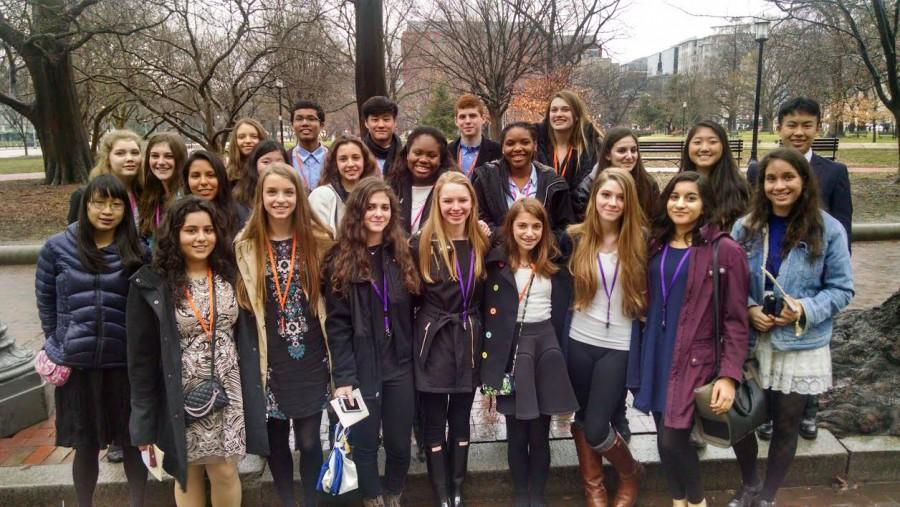Going to Washington is a Capital Opportunity
Photo courtesy of Amanda Marshall
U.S. History and art students got the opportunity to go to the White House Feb. 24 to hear Michelle Obama give a speech about overcoming adversity. The field trip also allowed the students to explore D.C.
March 22, 2016
CHS is a mere 30-minute drive from the center of the free world, the capital of our country, the District of Columbia.
According to Destination D.C., a part of Washington D.C.’s official website that monitors the rate of tourism, D.C. welcomed a total of 20.2 million visitors in 2014, setting a new record for the city. Among those 20.2 million tourists are families, foreigners, politicians and educational groups.
But not included amongst those 20.2 million? CHS students. While many students at CHS live close to D.C. and have visited before, they may not have gone on a guided group tour and have not taken advantage of all the educational opportunities that D.C holds. This needs to change.
According to AP US History and Psychology teacher Rodney VanTassell, anytime students can visit historical monuments or museums it will enhance their appreciation for history and government. There are so many great attractions in the D.C. area, and students should be able to take advantage of the educational opportunities they contains.
Providing an opportunity for a field trip to a D.C. museum or monument would get students excited about their United States government and history classes. Seeing the actual buildings and artifacts behind American history would create a unique connection between students and their learning.
Many students know their history and government classes can be boring at times. While it is crucial to know America’s history and the workings of its government, reading a dry textbook or listening to a teacher give a monotonal lecture is not always the best way to learn this important information.
It is true that teachers have to teach specific, sometimes boring, information, but there is no reason to not bring that information to life. Many of the documents and events that are studied in all U.S. history and government classes, regardless of AP or Honors status, have been archived in countless museums and monuments downtown. If students are reading the Constitution, a trip to the National Archives where the actual document is located would allow students to see that what they are learning about is not some ancient document that disappeared ages ago, but a real document that our nation is founded on.
In addition to living close to Washington D.C., CHS students are also closely located to presidential residences. Mount Vernon, George Washington’s home, is about an hour away, and John F. Kennedy’s bachelor pad is located in Georgetown, under 30 minutes away. Harry S. Truman, Bill Clinton and Franklin D. Roosevelt all had residences in D.C. at one point. In addition, students can also visit the current presidential residence—the White House. Students should be able to visit these hallowed grounds and learn about the men who lead our country in person, not just from a book.
When students learn about important events in American history, it often feels like they are far removed and ancient, and they feel little connection to those events. Reading and hearing about a topic is the way most subjects are taught, but as the saying goes, seeing is believing. Seeing important and influential artifacts from America’s history brings a student’s education to life as it gives him or her a direct visual of something that represents some of America’s most important moments.
A field trip to Washington would also be budget friendly.
According to the Montgomery County website, the BOE has a $2.5 billion budget plan for the 2017 fiscal year.
This huge amount of money goes towards numerous expenditures that help to keep our county running smoothly, but only a small portion, if any, would go toward field trips. On field trips students often pay their own costs, and many of the museums and monuments downtown are free to the public. There are 13 museums run by the Smithsonian Institution, which admits visitors for free, including the American History Museum and the Natural History Museum. In addition, all federal monuments are free to visitors.
The only money from the county that would go towards a field trip would be subsidization of transportation costs, which would be low. Students could meet at the Grosvenor-Strathmore metro station in Bethesda, where a metro ride to the Federal Triangle metro station located next to the National Mall would cost less than $10, round trip.
D.C is a city of politics, a city of culture, a city of business and a city of community. It is also a city full of rich history and incredible opportunities for students of all ages to learn about America’s past, present and future.


